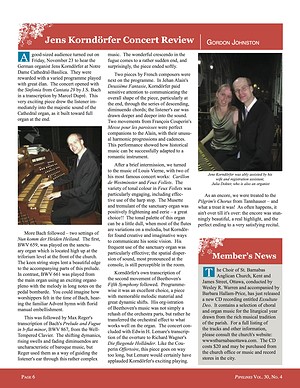Concert Review

A good-sized audience turned out on Friday, November 23 to hear the German organist Jens Korndörfer at Notre Dame Cathedral-Basilica. They were rewarded with a varied programme played with great élan. The concert opened with the Sinfonia from Cantata 29 by J.S. Bach in a transcription by Marcel Dupré. This very exciting piece drew the listener im- mediately into the majestic sound of the Cathedral organ, as it built toward full organ at the end.
More Bach followed – two settings of Nun komm der Heiden Heiland BWV 659, was played on the sanctu- ary organ which is located high up at the triforium level at the front of the church. The keen string stops lent a beautiful edge to the accompanying parts of this prelude. In contrast, BWV 661 was played from the main organ using an exciting organo pleno with the melody in long notes on the pedal bombarde. You could imagine how worshippers felt in the time of Bach, hear- manual embellishment.
This was followed by Max Reger's transcription of Bach's Prelude and Fugue Tempered Clavier. The shifting dymanics, rising swells and fading diminuendos are uncharacteristic of baroque music, but Reger used them as a way of guiding the listener's ear through this rather complex music. The wonderful crescendo in the fugue comes to a rather sudden end, and surprisingly, the piece ended softly.
Two pieces by French composers were next on the programme. In Jehan Alain's Deuxième Fantasie, Korndörfer paid sensitive attention to communicating the overall shape of the piece, particularly at the end, through the series of descending, diminuendo chords; the listener's ear was drawn deeper and deeper into the sound. Two movements from François Couperin's Messe pour les paroisses were perfect companions to the Alain, with their unusu- al harmonic progressions and cadences. This performance showed how historical music can be successfully adapted to a romantic instrument.
After a brief intermission, we turned to the music of Louis Vierne, with two of his most famous concert works: Carillon de Westminster and Feux Follets. The variety of tonal colour in Feux Follets was particularly engaging, including effec- tive use of the harp stop. The Musette and tremulant of the sanctuary organ was positively frightening and eerie – a great choice!! The tonal palette of this organ are variations on a melodia, but Korndörfer found creative and imaginative ways to communicate his sonic vision. His frequent use of the sanctuary organ was particularly effective; the spatial disper- sion of sound, most pronounced at the console, is still perceptible in the room.
Korndörfer's own transcription of the second movement of Beethoven's Fifth Symphony followed. Programme- wise it was an excellent choice, a piece with memorable melodic material and great dynamic shifts. His org-istration of Beethoven's music was not simply a rehash of the orchestra parts, but rather he transferred the orchestral effect to what works well on the organ. The concert con- cluded with Edwin H. Lemare's transcrip- tion of the overture to Richard Wagner's . Like the Couperin Offertoire, this piece goes on way too long, but Lemare would certainly have applauded Korndörfer's exciting playing.
As an encore, we were treated to the Pilgrim's Chorus from Tannhauser – and what a treat it was! As often happens, it ain't over till it's over: the encore was stun- ningly beautiful, a real highlight, and the perfect ending to a very satisfying recital.